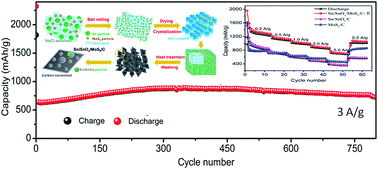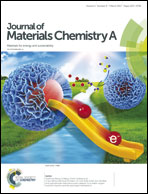Ultrasmall MoS2 embedded in carbon nanosheets-coated Sn/SnOx as anode material for high-rate and long life Li-ion batteries†
Abstract
A Sn/SnOx/MoS2/C composite material with superior performance was developed as an anode for lithium-ion batteries via a facile and scalable ball-milling method using a three-dimensional (3D) self-assembly of NaCl particles as a template. In the constructed architecture, carbon nanosheets avoided the direct exposure of encapsulated Sn/SnOx nanoparticles to the electrolyte and preserved the structural and interfacial stability of the nanoparticles, protecting them from volume expansion during the charge/discharge process. The MoS2 particles, uniformly dispersed on the carbon nanosheets, facilitate an efficient ion transport and ensure structural durability as a particle reinforcing agent. When used as an anode material in lithium-ion batteries, the as-prepared Sn/SnOx/MoS2/C composite exhibit a high rate performance and long cyclic stability, even at a high current density of 3 A g−1 (specific capacity of 725.3 mA h g−1 after 800 cycles). This simple fabrication method and the excellent electrochemical performance demonstrates the potential use of the Sn/SnOx/MoS2/C composite as an anode material for high-performance lithium-ion batteries.



 Please wait while we load your content...
Please wait while we load your content...